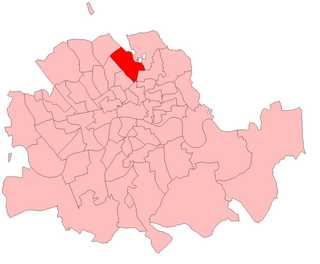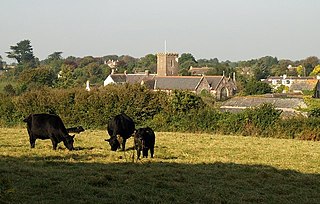
Torbay is unitary authority with a borough status in the ceremonial county of Devon, England. It is governed by Torbay Council, based in the town of Torquay, and also includes the towns of Paignton and Brixham. The borough consists of 24.27 sq mi (62.9 km2) of land around the east-facing Tor Bay, part of Lyme Bay on the English Channel. A popular tourist destination, Torbay's sandy beaches, mild climate and recreational and leisure attractions have given rise to its nickname of the English Riviera. The neighbouring districts are South Hams and Teignbridge.

Paignton is a seaside town on the coast of Tor Bay in Devon, England. Together with Torquay and Brixham it forms the borough of Torbay which was created in 1968. The Torbay area is a holiday destination known as the English Riviera. Paignton has origins as a Celtic settlement and was first mentioned in 1086. It grew as a small fishing village and a new harbour was built in 1847. A railway line was opened to passengers in 1859 creating links to Torquay and London. As its population increased, it merged with the villages of Goodrington and Preston. Paignton is around 25 miles (40 km) north east of Plymouth and 20 miles (32 km) south of Exeter.

South Hams is a local government district on the south coast of Devon, England. Its council is based in the town of Totnes, although the largest town is Ivybridge. The district also contains the towns of Dartmouth, Kingsbridge and Salcombe and numerous villages and surrounding rural areas.

Ashford is a constituency in Kent created in 1885 and represented in the House of Commons of the UK Parliament since 1997 by Damian Green, a Conservative who served as First Secretary of State between 11 June and 20 December 2017.

Totnes is a parliamentary constituency in Devon represented in the House of Commons of the UK Parliament since December 2019 by Anthony Mangnall, a Conservative. Mangnall defeated incumbent Sarah Wollaston who had originally been elected as a Conservative but defected to the Liberal Democrats earlier that year.
West Fife was a parliamentary constituency represented in the House of Commons of the Parliament of the United Kingdom from 1885 to 1974. Along with East Fife, it was formed by dividing the old Fife constituency.
East Grinstead was a parliamentary constituency in the Kingdom of England, the Kingdom of Great Britain, and the United Kingdom. It first existed as a Parliamentary borough from 1307, returning two Members of Parliament to the House of Commons elected by the bloc vote system. The borough was disfranchised under the Reform Act 1832, but the name was revived at the 1885 election when the Redistribution of Seats Act created a new single-member county division of the same name.

Houghton-le-Spring was a county constituency of the House of Commons of the Parliament of the United Kingdom from 1885 to 1983. Centred on the town of Houghton-le-Spring, now part of the City of Sunderland, it elected one Member of Parliament (MP) by the first-past-the-post system of election.

Ilkeston is a former United Kingdom Parliamentary constituency. It was a constituency of the House of Commons of the Parliament of the United Kingdom. It was represented by one Member of Parliament. In 1983 it was abolished, together with South East Derbyshire, when the Derbyshire county constituencies were redrawn - the constituencies of Amber Valley and Erewash were created and the constituency of South Derbyshire was re-created.

Oswestry was a United Kingdom Parliamentary constituency. It was a constituency of the House of Commons of the Parliament of the United Kingdom from 1885 to 1983, when it was renamed North Shropshire. It elected one Member of Parliament (MP) by the first past the post method of election.

Islington East was a constituency which returned one Member of Parliament (MP) to the House of Commons of the Parliament of the United Kingdom from 1885, until it was abolished for the February 1974 general election.

Gravesend was a county constituency centred on the town of Gravesend, Kent which returned one Member of Parliament (MP) to the House of Commons of the Parliament of the United Kingdom from 1868 until it was abolished for the 1983 general election. It is most notable for being a bellwether, with the winner of Gravesend winning every election from 1918 through to the present day except for 1929, 1951, and 2005.

Camborne was a county constituency in Cornwall which returned one Member of Parliament to the House of Commons of the Parliament of the United Kingdom. It was created for the 1885 general election, and abolished for the 1950 general election, when it was largely replaced by the new Falmouth and Camborne.

Clapham was a borough constituency in South London which returned one Member of Parliament (MP) to the House of Commons of the UK Parliament. It was created in time for the 1885 general election then altered in periodic national boundary reviews, principally in 1918, and abolished before the February 1974 general election. In its early years the seat was officially named Battersea and Clapham Parliamentary Borough: No. 2—The Clapham Division.
Howdenshire was a county constituency in Yorkshire which returned one Member of Parliament (MP) to the House of Commons of the Parliament of the United Kingdom, elected by the first past the post voting system.

Skipton was a county constituency centred on the town of Skipton in Yorkshire which returned one Member of Parliament (MP) to the House of Commons of the Parliament of the United Kingdom.
Liverpool Everton was a borough constituency represented in the House of Commons of the Parliament of the United Kingdom. It elected one Member of Parliament (MP) by the first past the post system of election.
Holderness was a parliamentary constituency centred on the Holderness area of the East Riding of Yorkshire. It returned one Member of Parliament (MP) to the House of Commons of the Parliament of the United Kingdom.
Kingswinford was a parliamentary constituency centred on the town of Kingswinford in Staffordshire. It returned one Member of Parliament (MP) to the House of Commons of the Parliament of the United Kingdom.

Churston Ferrers is an area and former civil parish, in the borough of Torbay, Devon, England, situated between the south coast towns of Paignton and Brixham. Today it is administered by local government as the Churston-with-Galmpton ward of the Torbay unitary authority. It contains the coastal village of Churston, the now larger village of Galmpton and the Broadsands area.














